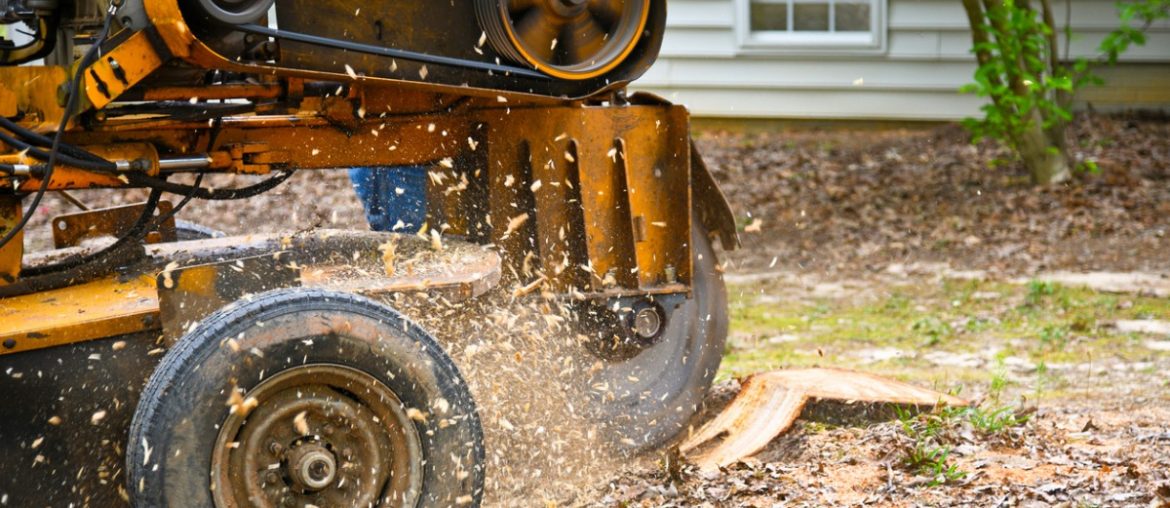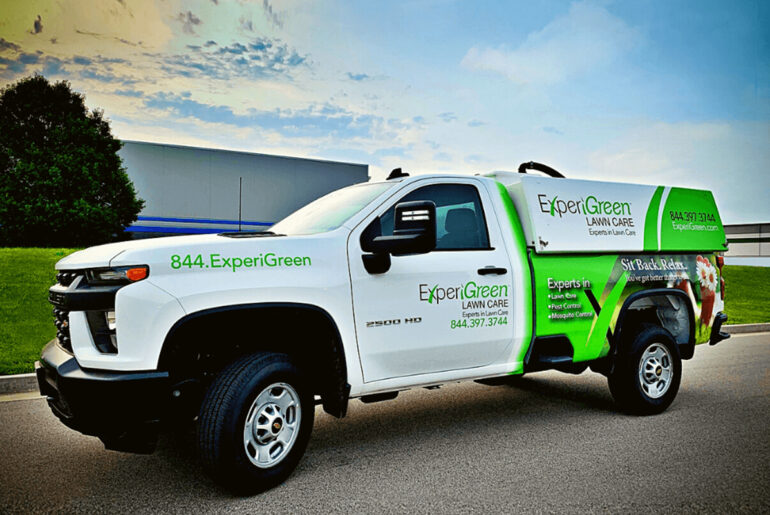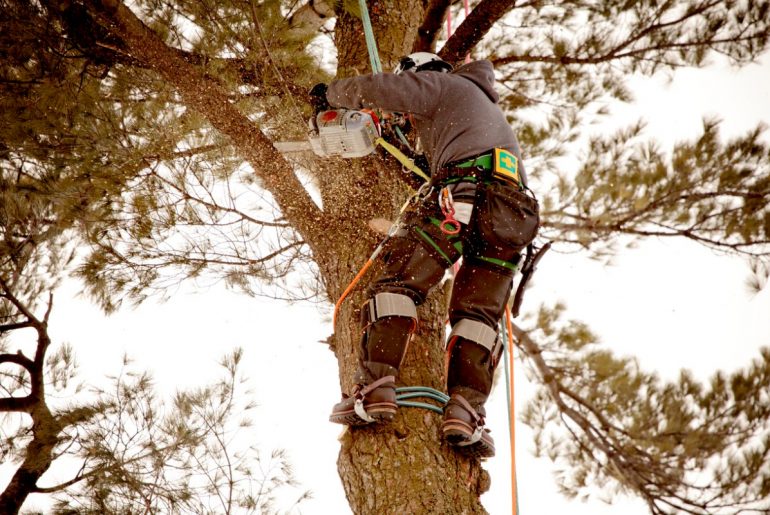Once a tree has been removed from a property, the next step is to get the stump out of the ground. However, stump removal is an expensive job, meaning most folks opt to grind the stump instead.
But, how much does a stump grinder cost? Are there any factors that affect the price of stump grinding, such as time or doing the project yourself? There are a lot of variables that change the price of stump grinding, so let’s take a look at what those variables are and how to account for them ahead of time.
How Much Does Stump Grind Cost?
The costs of stump grinding will differ based on several factors, like where you are and what the rest of the terrain looks like. As the cost of living in your area and the number of hazards of the worksite goes up, so will the cost.
Still, the American national average for stump grinding does not tend to go over a few hundred dollars. Specifically, the typical cost to grind a stump will be between $150 to $450 for the entire stump grinding project.
Here is a quick list of some of the upper and lower stump grinder prices you see around the country:
- National average: $313
- Typical cost: $158 to $450
- Low end: $158
- High end: $458
Every tree landscaping company will have some way to calculate prices, meaning that you’ll have to talk things out with the contractors to find out what the exact price in your area will be.
Factors That Affect the Price of Stump Grinding
As we mentioned, many factors affect how cheap or expensive a stump will be to remove. Here is a list of those factors and how they affect stump grinding costs:
Stump Type

Not all trees are equal when it comes to their wood. Depending on the area you live in, you’ll find that the trees have either light or dense wood to them. The type of wood affects the price of stump grinding by affecting how long it will take to grind down the stump.
Take, for example, a denser wood like aspen or oak. These trees leave behind a hard stump. To remove the stump, an arborist would need a stump grinder rental with enough power to grind the stump down. Meanwhile, lighter woods wouldn’t need the same kind of stump grinder to remove them.
How the kind of wood affects your stump grinding cost will depend on the arborist. Some arborists have a flat rate that they charge to remove stumps, no matter what kind of wood the project entails. Others will instead charge a variable price per square inch of stump based on what kind of tree stump you need to remove.
Finally, some arborists will charge by the hour. For these services, the workers will clock their time to remove any stumps, and then bill the client for the time spent on the site. Harder woods will mean the workers grind fewer stumps per hour, so be prepared for a large bill if you need a big number of dense stumps ground down.
Number of Stumps to Grind
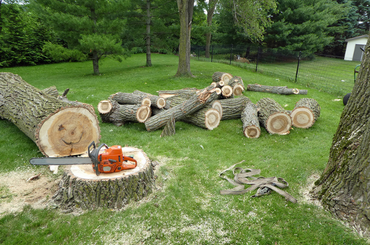
Speaking of the number of stumps, this factor will change the price of your stump grinding, too. As the number of stumps that need removing goes up, the price should go up since the arborists will have to labor longer on the project to see it through.
The good news is that many tree landscaping companies have rates that will affect the total price as the number of stumps goes up. Usually, this means that these companies charge less per stump as the number of stumps goes up.
The main reason why these companies do this is that they won’t have to send their crew all over the place for these larger projects. Removing multiple stumps from a single project location is much easier to do than going to six different sites to remove a single stump since the arborists won’t have to move and reset equipment all over town.
Also, some companies will charge per hour, rather than per stump. While the number of stumps will affect how long the project takes, going with an hourly rate could be less expensive than paying per stump, depending on how many stumps you need ground down for a property.
Project Completion Time

Many tree professionals tend to charge by the hour for their projects. While this works great for small projects that should only take a few hours, larger projects can mean a higher expense.
Clearing out a section of trees from a large property will mean that the tree professionals have to dedicate more time to clearing out the area than if they just had one tree to do on the property. An hourly rate means that, no matter how many stumps the team clears out per hour, you’ll be paying for their services every hour they are on the clock.
While this isn’t a problem if the team can work fast, anyone with some project management experience knows that the longer a project takes, the better the chance something goes sideways.
For example, many arborists rely on good soil conditions to ensure that grinding a stump will be good for the surrounding area. Stump grinders use heavy metal blades to grind up the stump, meaning that poor, rocky soil will eat up those blades and cause damage as the machine works. Having a large number of stumps to grind in this soil could mean the arborist charges you for equipment maintenance.
If you didn’t know this ahead of time, it will mean the stump grinding team has to take more time replacing or maintaining the grinder blades and less time removing stumps. This increases the overall cost of the project.
Inspections for the worksite ahead of time can help prevent some of these mid-project headaches and give the arborists a better idea of what their work will entail.
Surrounding Terrain
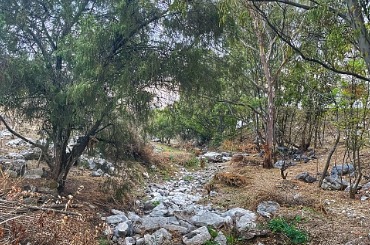
Speaking of inspections, surveying the area ahead of time will also give an arborist an idea of how they will be able to maneuver their equipment during the project.
Hazardous or tricky terrain can be found ahead of time during these initial inspections. While it stings to pay a higher price over something you can’t control, the arborist has to think about the safety of themselves and the rest of the team and factor that into the price of the project.
For example, hills and other slopes will increase the total cost of stump grinding. This upcharge comes from the fact that the stump grinder is hard to navigate on slopes and hills, increasing the safety risks to the team and the property. This upcharge makes the project worth the team’s time.
Tricky terrain may also just cause the project to take longer. It’s one thing to grind a stump, but another entirely to grind a tree stump that’s right next to a busy street or a power line. These hazards mean the team has to be more careful when it moves around the job site, increasing the hazards of the job.
Generally, terrain won’t be its own category on the bill. Rather, the terrain will play a part in how much time it takes to grind the stump and get everything else done. The more difficulties a job site has native to it, the longer and more expensive the job will be.
Debris Removal
Once the stump grinding finishes, the team can pack up and finish out the job. Because grinding a stump creates mulch, the owner of the property has to decide what to do with this excess wood.

Some property owners will decide to keep the mulch in the hole to prevent leaving a giant hole in the ground. Others will decide to move the mulch to landscape or gardens elsewhere on the property so they don’t have to pay for bagged mulch from the home and gardening store. Others will want the mulch removed from the site.
The problem with having the mulch removed is that it isn’t a standard part of stump grinding. Hauling mulch away from the job site entails moving the mulch onto the back of a truck and shipping that mulch off to a landfill or composting site. This truck is different than the one that brings in the stump grinder, meaning the tree professionals have to bring more equipment to the worksite for mulch removal.
In general, arborists will offer to haul the mulch away for an extra fee, usually measured in dollars per square foot of stump ground down. The larger the stump, and the more of them there are, the more expensive having the mulch hauled away will be.
Other Location Factors
While the things we listed earlier are the major players in the price of stump grinding, there are plenty of other factors you might have to think about when figuring out the price.
For example, rural projects might be far away from the main office or building an arborist keeps their equipment in. Some services will charge for the mileage driven to get out to the work site, usually enough to pay for gas and wear and tear on the vehicles from being on the road.

Special permits can also increase the cost of stump grinding. Utility lines underneath the landscape, protection placed on certain species of trees, green space requirements, and other legal factors can mean that permits have to be obtained before the project can begin. Permit applications have fees, meaning they are other potential expenses to your project.
Also, some landscaping companies offer sodding as a follow-up service to grinding down a tree stump. With this service, the landscaper sods over the hole created by the grinding process, filling in that spot and making it look nicer than letting the grass grow back naturally. As an extra service, sodding costs more than just leaving the hole filled with mulch or empty.
How to Estimate the Cost of Your Stump Grinding
Most stump grinding services go with a flat rate per inch of stump diameter to determine the price they charge. Typically, this fee is between two and four dollars per inch across the stump. This range means that a 30-inch stump at three dollars per inch would cost $90 to grind down.
However, many arborists have a minimum price that they set to grind down a stump to cover costs for labor, moving equipment, and time investment. Generally, the national average for this minimum is $100.
If you want to get an idea of the base price of your stump grinding, measure off the tree stump across its widest point. From there, multiply the measurement by two or four to get an idea of the minimum and maximum price you should expect, respectively.
Get Started With Tree Care Software!
Services To Pair With Stump Grinding
Stump grinding doesn’t usually happen on its own. Instead, stump grinding tends to be part of a larger package of tree landscaping services. Here are some of the other services that tend to be paired with stump grinding by customers:
Root and Bulb Removal

Stump grinding does not usually come with root removal. Roots can look ugly when not connected to a tree and can also be tripping hazards for folks walking nearby.
Generally, consumers request that arborists remove the tree roots from the area of the ground stump for those reasons. This process will come with an extra cost but helps improve the look and safety of the area the stump was once in.
Tree Removal
Generally, folks ask for a professional to come by and cut down a tree for them. Because of the size of the project and safety issues with chopping down trees, it’s best left to professionals anyway.
Many arborists will offer removal services including stump grinding at a reduced price if someone wants a tree removed. Someone ordering a tree removal usually means they have other plans for the area the tree stump is in, so it’s a simple inclusion to the project.
Tree Trimming
Sometimes, trees have to be removed because nearby trees have grown past the tree, causing them to become diseased or die. Diseased and dead trees can be fire and safety hazards, leading to folks asking to remove them.
To prevent that from happening to future trees, you can talk to your tree professionals about having some of the nearby trees trimmed for a little more cost. That way, a newly planted tree in the place of the old one has a chance to grow into the space and stay healthy.
Tree Transplanting
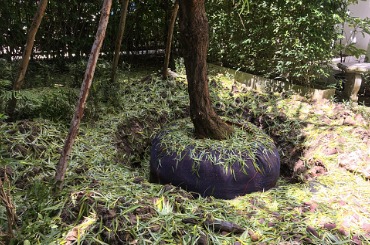
In other cases, moving a tree is better than removing it entirely. This fact especially holds when the tree in question is a protected species or when the property has to have a certain amount of greenery or green space on it.
An arborist can get the tree moved to a different spot on your property if any of these reasons are in effect. That way, you stay within the rules and you get to keep a beautiful piece of greenery.
DIY Stump Grinding vs. Professional Stump Grinding
Some home and business owners would rather do their project themselves than have to go through the trouble of bringing in an arborist to remove a tree stump. Before doing that, there are several things to keep in mind about doing your own stump grinding:
How To Determine the Price of DIY Stump Grinding
The main factors in the price of DIY stump grinding are the tools you need to get and the time it will take to do it yourself.
Having the tools to tackle the project yourself will save a lot of the initial cost. To safely remove your stumps, you’ll want this list of gear:
- Safety glasses
- Thick work gloves
- Hearing protection
- A chainsaw
- Chainsaw chaps
- Steel toe work boots
The chainsaw is what you use to get the stump as close to ground level as possible before using the stump grinder. The rest of the equipment is safety gear to protect your body and hearing while working with a loud and dangerous power tool.
If you don’t have any of these items, you’ll have to get them for yourself. Altogether, this list of gear would cost between $300 and $400, meaning that hiring a professional would be cheaper than a DIY method from scratch.
Renting a Stump Grinder
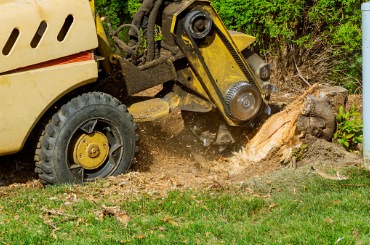
In addition to the gear listed above, you’ll need to rent a stump grinder from someone to grind the stump down into mulch. Many home improvement and hardware stores will have stump grinders for rent, making it relatively easy to grab a stump grinder if you live near one of these stores.
Most places rent grinders for a full day. Since it will usually take a few hours to grind one stump, you can usually rent a stump grinder for the day if you only need one stump removed. Most hardware stores will rent out a stump grinder for $200 to $400 per day.
When combined with the gear list we have above, that means that starting from nothing will put you well above the price you’d expect to pay for a professional to come out and tackle the job for you. Still, the gear we listed above has uses outside of grinding stumps.
DIY Stump Grinding Pros and Cons
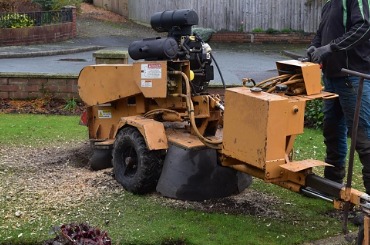
Tackling a DIY project can be satisfying, but there are more benefits to stump grinding than just good feelings. Here are the positives of doing your own stump grinding:
- Cheaper than hiring a pro if you already have the gear on hand.
- You won’t have to wait for a professional to come out and inspect the property.
- Can be done at your pace, rather than someone else’s.
However, these pros don’t mean there are no downsides to tackling this kind of project alone. When you do this yourself, these negatives can show up:
- Professionals know the safety hazards and zoning rules to get the job done right.
- If you don’t have the gear, then the price could be double or more than hiring a pro.
- Arborists tend to package other services into their stump grinding, like tree trimming and tree transplanting.
Basically, unless you have the gear and know-how ahead of time, bringing in a professional arborist or landscaping team will give you a better outcome. Also, since you won’t be paying for the gear, professional help will usually be cheaper, too.
Stump Grinding Alternatives
If you want to take a different approach to get rid of a stump, there are other ways to remove it. Here are some of the other physical and chemical solutions you could take to kill and remove a stump from your property:
Stump Burning
Stump burning involves setting the leftover tree stump on fire using a combustible accelerant, typically potassium nitrate. This material tends to cost less than $100 and, if done safely, can be done by just about anyone.
The main concern around stump burning is fire safety. You’ll need to ensure that the area around the stump is free of flammables or other combustible materials. It also doesn’t hurt to have a way to extinguish the fire in case things get out of hand.
Also, you’ll want to call your local fire department before you do this. Fire bans go out without a heads-up to the surrounding area sometimes. So, by calling your local fire station, you’ll be able to stay within the bounds of local laws and also get some fire safety tips from the pros before doing this DIY route.
Finally, expect the stump to burn for several hours, especially if the stump is big. You’ll want to watch the fire the entire time it is burning, so grab a comfy chair or blanket and enjoy the warm fire.
Chemical Rotting
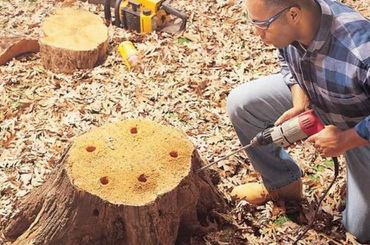
This process uses the same materials as the stump-burning method: potassium nitrate. However, instead of setting fire to the stump, chemical rotting involves allowing the potassium nitrate to soak into the stump and roots, rotting the stump from the inside out over several weeks.
Since potassium nitrate is poisonous, you’ll want to handle the material with care. Avoid any errant sparks to keep the nitrate from going up in flames before it has a chance to soak into the stump.
Finally, be careful with how you sow the nitrate into the stump. The potassium nitrate will kill off not only the stump but also the surrounding landscaping if you are not careful. Chemical rotting tends to work best for stumps of trees that are far away from other yard or landscape elements because of this, so keep the terrain in mind before using this method.
Physical Removal
Finally, there is the classic way of removing a stump on your own: using an ax and shovel to pull it out of the ground. While this method isn’t the easiest to do, it is definitely the cheapest, especially if you already have the tools on hand.
The main benefit of using this method is that you can be as thorough as you want. With chemicals, you rely on the proper placement of the chemicals to kill it from the inside out. With physical tools, you can go through the soil yourself and ensure that the entire stump and the associated roots come out.
Even if you do not have the tools, buying a shovel and ax will serve other benefits down the road, unlike potassium nitrate. Shovels and axes make for good gardening and landscaping tools in other projects, while chemicals like potassium nitrate are more specialized.
Stump Grinding Cost FAQs
Here are some of the common questions out there about stump grinding costs and details:
What Is the Difference Between Stump Grinding and Stump Removal?
While stump grinding involves turning the stump down into mulch with a grinder, stump removal requires the physical extraction of the stump from the earth. Stump removal is a complete disposal process, while stump grinding is less expensive.
Does Tree Removal Include Stump Grinding?
While many arborists will offer stump grinding as part of their tree removal package, it is not a guaranteed part of every tree removal package. If you are not sure if your arborist will grind the stump after removing a tree, ask before any agreements are made.
Can Stump Grinding Be Bundled With Other Tree Landscaping Services?
Stump grinding can be, and generally is, included with other tree landscaping services. Many arborists will include stump grinding as part of their tree removal package to give their clients a way to save money and improve the look of their property.
Why Should You Grind Stumps?
Stump grinding is less expensive than hiring a professional to do a total removal of the tree stump. Additionally, stump grinding produces a lot of mulch, which has a variety of landscaping and gardening uses that savvy businesses or property owners could use to their advantage.
Summary
The price of stump grinding relies on several factors, like how many stumps you need to ground down and what the surrounding area looks like. Each factor can affect the project’s price, with difficult circumstances increasing the total cost.
Generally, your best bet is to have a professional come out ahead of time and assess the site first. By getting another pair of eyes on the area, you can get a better idea of how much the project will cost by cutting back on the chance that something unexpected comes up mid-project, keeping your business running smoothly.

